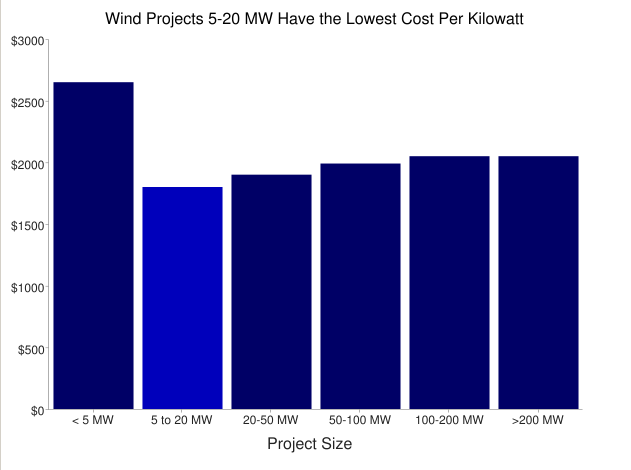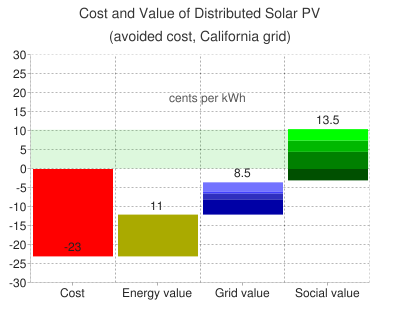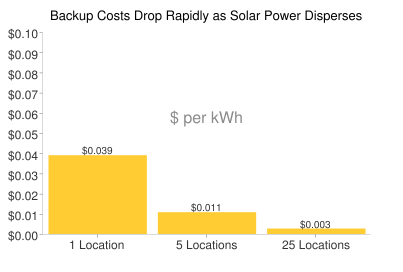While seeming counterintuitive, a focus on smaller-scale distributed generation enables more and faster development of cost-effective renewable energy.
In April, I wrote about the illusion that we can “move forward on all fronts” in renewable energy development; rather, a bias toward centralized electricity generation in U.S. policy reduces the potential and resources for distributed generation.
 Solar economies of scale level off at 10 kilowatts.In contrast, distributed generation provides unique value to the grid and society, and its development can also smooth the path for more centralized renewable energy generation.
Solar economies of scale level off at 10 kilowatts.In contrast, distributed generation provides unique value to the grid and society, and its development can also smooth the path for more centralized renewable energy generation.
First, distributed generation is cost-effective. Economies of scale for the two fastest-growing renewable energy technologies (wind and solar) level off well within the definition of distributed generation (under 80 megawatts and connected to the distribution grid). Solar PV economies of scale are mostly captured at 10 kilowatts, as shown in this chart of tens of thousands of solar PV projects in California. Wind projects in the U.S. are most economical at 5-20 megawatts, illustrated in a chart taken from the 2009 Wind Technologies Market Report.

 Besides providing economical power relative to large-scale renewable energy projects, distributed renewable energy generation also has unique value to the electric grid. Distributed solar PV provides an average of 22 cents per kWh of value in addition to the electricity produced because of various benefits to the grid and society. The adjacent chart illustrates with data coming from this analysis of the New York electric grid. Grid benefits include peak load shaving, reduce transmission losses, and deferred infrastructure upgrades as well as providing a hedge against volatile fossil fuel prices. Social benefits include prevented blackouts, reduced pollution, and job creation.
Besides providing economical power relative to large-scale renewable energy projects, distributed renewable energy generation also has unique value to the electric grid. Distributed solar PV provides an average of 22 cents per kWh of value in addition to the electricity produced because of various benefits to the grid and society. The adjacent chart illustrates with data coming from this analysis of the New York electric grid. Grid benefits include peak load shaving, reduce transmission losses, and deferred infrastructure upgrades as well as providing a hedge against volatile fossil fuel prices. Social benefits include prevented blackouts, reduced pollution, and job creation.
Distributed wind and solar also largely eliminate the largest issue of renewable power generation – variability. Variability of solar power is significantly reduced by dispersing solar power plants. Variability of wind is similarly reduced when wind farms are dispersed over larger geographic areas.
 Not only are backup costs reduced, but periods of zero to low production are virtually eliminated by dispersing wind and solar projects over a wide area.
Not only are backup costs reduced, but periods of zero to low production are virtually eliminated by dispersing wind and solar projects over a wide area.
As mentioned at the start, distributed generation also scales rapidly to meet aggressive renewable energy targets. Despite the conventional wisdom that getting big numbers requires big project sizes, the countries with the largest renewable energy capacities have achieved by building distributed generation, not centralized generation. Germany, for example, has over 16,000 megawatts of solar PV, over 80 percent installed on rooftops (and at an average price – $3.70 per Watt – far less than in the U.S.). Its wind power has also scaled up in small blocks, with over half of Germany’s 27,000 megawatts built in 20 megawatt or smaller wind projects. In Denmark, wind provides 15-20 percent of the country’s electricity, and 80 percent of wind projects are owned by local cooperatives.
With all these benefits, distributed generation can also smooth the way for centralized renewable energy, in spite of energy policies that favor centralized power. When distributed generation reduces grid stress and transmission losses by provided power and voltage response near load, it can defer upgrades to existing infrastructure and open up capacity on existing transmission lines for new centralized renewable energy projects. A focus on distributed generation means more opportunity for all types of renewable energy development.
It may seem counterintuitive, but distributed renewable energy should be the priority for reaching clean energy goals in the United States.



